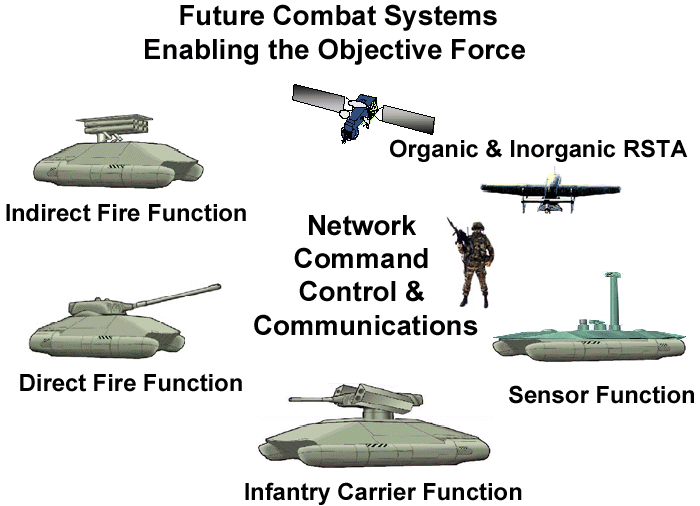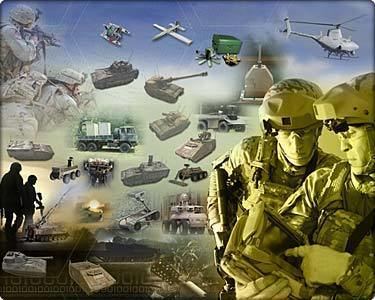 | ||
Future Combat Systems (FCS) was the United States Army's principal modernization program from 2003 to early 2009. Formally launched in 2003, FCS was envisioned to create new brigades equipped with new manned and unmanned vehicles linked by an unprecedented fast and flexible battlefield network. In April and May 2009, Pentagon and army officials announced that the FCS vehicle-development effort would be cancelled. The rest of the FCS effort would be swept into a new, pan-army program called the Army Brigade Combat Team Modernization Program.
Contents

Development history

As planned, FCS included the network; unattended ground sensors (UGS); unmanned aerial vehicles (UAVs); unmanned ground vehicles; and the eight manned ground vehicles.
The Boeing Company and Science Applications International Corporation (SAIC) worked together as the lead systems integrators, coordinating more than 550 contractors and subcontractors in 41 states.

A spiral model was planned for FCS development and upgrades. As of 2004, FCS was in the System Development and Demonstration (SDD) phase, which included four two-year spirals. Spiral 1 was to begin fielding in Fiscal Year 2008 and consist of prototypes for use and evaluation. Following successful evaluation, production and fielding of Spiral 2 would have commenced in 2010. The evaluation was conducted by the Army Evaluation Task Force (AETF), previously known as Evaluation Brigade Combat Team (EBCT), stationed in Fort Bliss. As of December 2007, AETF consisted of 1,000 soldiers from the 1st Armored Division.

In August 2005, the program met 100% of the criteria in its most important milestone to date, Systems of Systems Functional Review. On October 5, 2005, Pentagon team recommended "further delaying the Army's Future Combat Systems program" in light of the costs of the Iraq War, Hurricane Katrina, and expected declines in future budgets.

The Pentagon announced plans in January 2006 to cut $236 million over five years from the $25 billion FCS 2007–2011 budget. The entire program was expected to cost $340 billion. As of late December 2006, funding was scaled back for critical elements of the overall FCS battlespace, and the most advanced elements were deferred.
The program had completed about one-third of its development as of 2008, which had been planned to run through 2030. Technical field tests began in 2008. The first combat brigade equipped with FCS had been expected to roll out around 2015, followed by full production to equip up to 15 brigades by 2030. However, the program had not met the initial 2004 plan of fielding the first FCS-equipped unit in 2008.
On April 6, 2009, President Barack Obama's Secretary of Defense, Robert Gates announced plans to cut FCS spending as part of a shift toward spending more on counter-terrorism and less to prepare for conventional warfare against large states like China and Russia. This included, but was not limited to, cancelling the series of Manned Ground Vehicles.
In May 2009, the proposed DoD budget for fiscal year 2010 has minimal funding for Manned Ground Vehicles research. The Army plans to restart from the beginning on manned ground vehicles. The service is to restructure FCS so more Army units will be supported.
The DoD released a memorandum on 23 June 2009 that cancelled the Future Combat Systems program and replaced it with separate programs under the Army Brigade Combat Team Modernization umbrella to meet the Army's plans.
Active Subsystems
The following subsystems were swept into the Brigade Combat Team Modernization Program:
Operating system
FCS was networked via an advanced architecture, called System of Systems Common Operating Environment (SOSCOE) that would enable enhanced joint connectivity and situational awareness (see Network-centric warfare). SOSCOE targets x86-Linux, VxWorks, and LynxOS. The FCS (BCT) network consists of five layers that when combined would provide seamless delivery of data: The Standards, Transport, Services, Applications, and Sensors and Platforms Layers. The FCS (BCT) network possesses the adaptability and management functionality required to maintain pertinent services, while the FCS (BCT) fights on a rapidly shifting battlespace giving them the advantage to take initiative. FCS would network existing systems, systems already under development, and systems to be developed.
